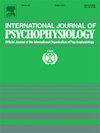在威胁条件反射中对副交感神经和交感神经唤起的解释的相关性:方法学和临床考虑。
IF 2.5
3区 心理学
Q3 NEUROSCIENCES
引用次数: 0
摘要
联想威胁学习的改变被认为是焦虑障碍的病因和维持的基础。最近对副交感神经唤起对威胁应对的促进作用的研究提出了一个问题,即在威胁学习过程中,交感神经和副交感神经支配的个体差异是否可能揭示焦虑、脆弱和恢复力之间的复杂关系。我们在78名神经正常个体中应用了一种已建立的差分线索延迟威胁条件反射范式,并评估了副交感神经反应(威胁诱发的心动过缓)以及交感神经反应(威胁诱发的心动过速和皮肤电导反应增加- scr)。我们发现证据表明,威胁诱发的心动过缓和心动过速的模式存在于联想学习过程中。威胁性心动过缓与较弱的初始条件SCR相关(主要由对CS+的反应驱动),这一发现可能与当前威胁学习领域的常见实践有关:即具有弱差异皮肤电导反应的参与者-根据常用的“SCR非学习者”标准通常被视为非学习者,有时甚至被排除在分析之外-实际上在副交感神经唤醒方面表现出成功的学习。此外,威胁性心动过缓的存在以及总体条件心率反应的大小与相对较低的特质焦虑有关。这些发现不仅具有实际的研究意义,而且在评估焦虑、脆弱和恢复力的标记时具有临床意义。本文章由计算机程序翻译,如有差异,请以英文原文为准。
The relevance of accounting for parasympathetic as well as sympathetic arousal in threat conditioning: Methodological and clinical considerations
Alterations in associative threat learning have been thought to underlie the aetiology and maintenance of anxiety disorders. Recent insights into the facilitatory role of parasympathetic arousal for threat coping have raised the question whether individual differences in sympathetic versus parasympathetic dominance during threat learning may shed light on the complex relationship with anxiety vulnerability versus resilience. We applied an established differential-cue delay threat conditioning paradigm in 78 neurotypical individuals and assessed parasympathetic responses (threat-induced bradycardia), as well as sympathetic responses (threat-induced tachycardia and increased skin conductance responses-SCR). We found evidence that patterns of threat-induced bradycardia as well as tachycardia are present during associative learning. Threat bradycardia was linked to weaker initial conditioned SCRs (mainly driven by responses to the CS+), a finding that may be relevant for current common practice in the field of threat learning: namely participants with weak differential skin conductance responses - who according to frequently applied ‘SCR non-learner’ criteria are often considered non-learners and sometimes even excluded from analyses - were in fact showing successful learning in terms of parasympathetic arousal. Additionally, the presence of threat bradycardia as well as the magnitude of overall conditioned heart rate responses were linked to relatively lower trait anxiety. These findings not only have practical research implications but also clinical implications when assessing markers for anxiety vulnerability versus resilience.
求助全文
通过发布文献求助,成功后即可免费获取论文全文。
去求助
来源期刊
CiteScore
5.40
自引率
10.00%
发文量
177
审稿时长
3-8 weeks
期刊介绍:
The International Journal of Psychophysiology is the official journal of the International Organization of Psychophysiology, and provides a respected forum for the publication of high quality original contributions on all aspects of psychophysiology. The journal is interdisciplinary and aims to integrate the neurosciences and behavioral sciences. Empirical, theoretical, and review articles are encouraged in the following areas:
• Cerebral psychophysiology: including functional brain mapping and neuroimaging with Event-Related Potentials (ERPs), Positron Emission Tomography (PET), Functional Magnetic Resonance Imaging (fMRI) and Electroencephalographic studies.
• Autonomic functions: including bilateral electrodermal activity, pupillometry and blood volume changes.
• Cardiovascular Psychophysiology:including studies of blood pressure, cardiac functioning and respiration.
• Somatic psychophysiology: including muscle activity, eye movements and eye blinks.

 求助内容:
求助内容: 应助结果提醒方式:
应助结果提醒方式:


